 Russian Empire, 1902-1904
Russian Empire, 1902-1904Boyarin (“Nobleman”) was a protected cruiser of the Imperial Russian Navy. She was the only foreign built cruiser to be built at Burmeister & Wain in Copenhagen, Denmark in the rapid buildup preceding the Pacific. Varyag has been built also for the Russian Pacific Fleet, but in the US, Askold in Germany, as Bogatyr, Novik prior ro this. She had therefore a fairly short career, sunk by a Russian naval mine near Port Arthur entrance after the start of the 1904 Russo-Japanese War. #ww1 #russianimperialnavy #russianavy #russkyflot #boyarin #portarthur #russojapanasewar
The Danish-built Pacific cruiser
With the acquisition of Lüshunkou (now a district of Dalian, largest PLAN shipyard), renamed Port Arthur, after the conclusion of the 1st Sino-Japanese war, the expanding Russian Empire had a windown on the Pacific in betweer waters than Vladivostok and started to rapidly increase its naval power here. The port and base, arsenal were developed and fortifications added, but the Admirakty wanted a fleet of second-rank protected cruisers, four, to reinforce it on 15 April 1899. At first a contract precised they would be built in Danzig, and on the design of the Novik tasked for reconnaissance, as scout, as despatch vessel and to support destroyer squadrons. Political pressure from the throne however revised the contracts specifications and instead if Schichau, the contract was passed onto Danish largest yard at the time, Burmeister & Wain, as the Dowager Empress Maria Feodorvna was from Denmark at the time.
Construction
The issues were many, starting with the much higher cost of the cruiser (larger than expected due to higher wages) and that the shipyard was relatively ill-equipped and inexperienced in cruiser construction, at least at this scale, seeking advices and importing many components, causing delays and extra cost. Changes were also made to the design which reinforced armament, but created conversely new stability issues, and efforts to compensate these by buffing and ballasting the crew, rising from 2,600 tons to 3,075 tons with a loss of speed. In the end, Boyarin proved inferior to Novik in speed, general layout, but also ammunition storage or mines. She was less useful overall.
Burmeister & Wain so far only had the experience of a single small protected cruiser, the 1,200 tonnes Gejser in 1892, while Copenhagen built the Heimdal (1894), earlier Hekla (1890) and Valkyrien (1888), Fyen (1882) as well as practically all the rest of the Danish fleet. This was a young yard, not familiar to military construction and later best known for its gargantuan diesels for civilian use.
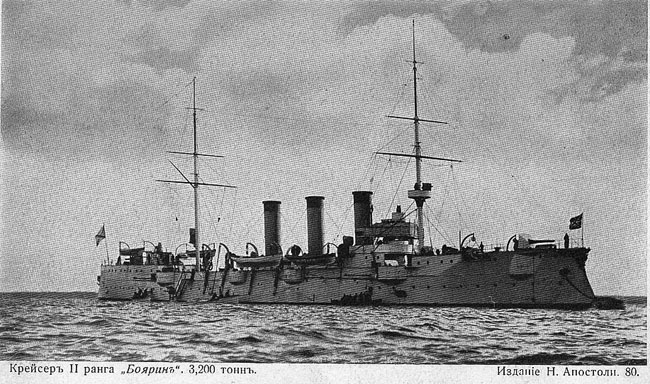
The keel of Boyarin was laid of 24 September 1900. Commander V I Litvinov was present at the yard as chief equipping officer. Boyarin was launched on 26 May 1901 but there was no presence of anyone from the Imperial Russian Navy at the ceremony only attended by the Russain ambassador and lower rank personal, as well as the yard’s staff. None from the Danish Royal house as well. After launch Boxer rebellio veteran (gunboat Gilyak), Commander Vladimir Fedorovich Sarychev was appointed. Acceptance trials by June 1902 showed severe vibrations and the contracted speed of 22 knots as contracted was met with usch issues that the practical operational speed was to be reduced to 14 knots. This made the cruiser inable to perform its main tasks as scout or destroyer leader.
Design of the class
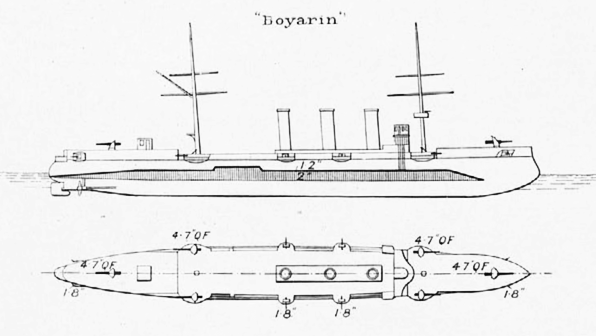
Hull and general design
Boyarin was very different from Novik. She was shorter, beamier and about 200t heavier, at 3,200 long tons (3,251 t) 105.2 m (345 ft) overall to the tip of her ram, 12.5 m (41 ft) in beam and 4.88 m (16 ft) in draught, less than Novik. Her profile could not be more different. She was symmetrical, with a forecastle and poop deck, and two equal size masts and three close together funnels forward amidships wheras Novik had only a forecastle, three heavenly spaced low funnels and a single mast.
Armour protection layout
The armour could not be procured locally, this was imported Krupp plating, 50 mm (2 in) for the turtle deck 76 mm (3 in) on the conning tower. There was no armoured belt. This was comparable to the Novik, which hower had a 2-in sloped deck and only 3-in over the machinery.
Powerplant
The powerplant consisted of two shafts, driven by two B&W triple expansion steam engines, fed in turn by 16 imported Belleville-type boilers. The Russians insisted on this point as they knew the model well. But the end performances were absolutely disappointing. The reciprocating vertical triple-expansion steam engines coupled with the boilers could only produce 8,600 kW (11,500 hp), and the contracted speed of 22 knots (41 km/h, 25 mph) was only met with massive vibration issues. This was bad enough to prevent any use of the artillery, at least accuratelty at this top speed. For daily operations, it was decided that, as the vibrations issues would not be cured -she was needed urgently- 14 knots would be ideal, severly restricting her usefulness.
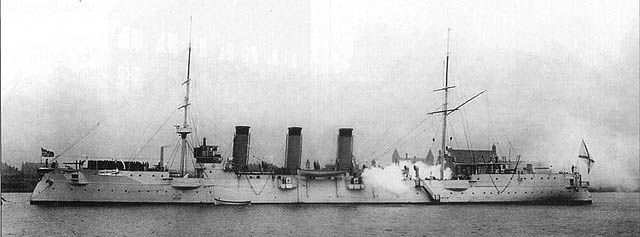
Armament
The Main armament was a replication of the Novik, with six 120 mm (4.7 in) French Canet guns, all in shielded mountings: One at the bow and stern, four in sponsons.
6x 120 mm (4.7 in) Canet guns
8x Hotchkiss rapid fire 47 mm (1.9 in) guns
4x 37 mm (1.5 in) Hotchkiss guns
2x Maxim machine guns
5x 381 mm (15 in) torpedo tubes
120 mm 45 caliber Pattern 1892
Design by Canet, France, 1891, manufactured under licence by Obukhov, Perm. Installed on a lot of armoured and protected cruisers among others. This was the default secondary gun of the Russian Imperial Navy for two decades.
⚙ specs Canet 120 mm 45 caliber Pattern 1892 |
|
| Weight | 2.95 t (3.25 short tons) |
| Barrel lenght | 5.4 m (17 ft 9 in) oa, barrel 4.2 m (13 ft 9 in) |
| Elevation/Traverse | -7° to +20°, c170-300° arc |
| Loading system | Breech of the piston type |
| Muzzle velocity | 823 m/s (2,700 ft/s) |
| Range | 11.8 km (7.3 mi) at +20° |
| Guidance | Visual |
| Crew | c11 |
| Round | Fixed QF ammunition 20.4 kg (45 lb) 4.7 in, 45 caliber |
| Rate of Fire | 12-15 rpm |
Anti-Torpedo Boat Armament:
Anti-torpedo boat armament consisted of eight 47 mm guns, four in the bow and stern casemates and four in midship sponsons.
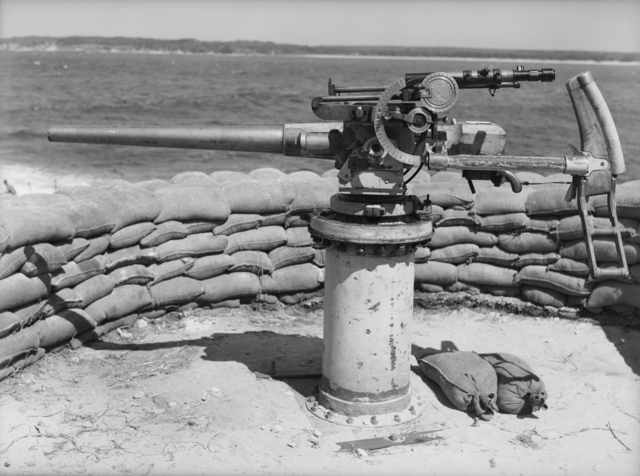
Single mount 47 mm (3-pdr) Hotchkiss gun. First produced in 1885. Quickspecs: Weight, 240 kg in firing position, Barrel length 43.5 mm/47 caliber ROF 15 rpm, sighting range 4.6 km.
37 mm Hotchkiss
A model that can be dismounted to be relocated on a pintle fitted on a steam cutter. Similar to the French model Hotchkiss cannon.
Optional: Maxim-Nortdenfelt 0.8 mm machine guns
Torpedo Armament:
Five torpedo tubes with 11 torpedoes, placed one on the stern and two on each side, all above water.
Whitehead type, 15″ (381mm) Type “L”, 1898
Wargead 141 lbs. (64 kg) TNT, Range/Speed 980 yards (900 m)/25 knots or 660 yards (600 m)/29 knots
⚙ specifications |
|
| Displacement | 6,500 long tons (6,604 t) |
| Dimensions | 129.6 x 15.8 x 6.3 m (425 ft 2 in x 51 ft 10 in x 20 ft 8 in) |
| Propulsion | 2 shafts VTE, 30 Niclausse boilers 20,000 ihp (15,000 kW) |
| Speed | 23 knots (43 km/h; 26 mph) |
| Range | 6,100 miles |
| Armament | 12× 152mm, 12× 75mm, 8× 47mm, 2× 37 mm, 6× 381 mm TTs |
| Protection | See notes |
| Crew | 570 |
Read More
Books
Brook, Peter (2000). “Armoured Cruiser vs. Armoured Cruiser: Ulsan 14 August 1904”. In Preston, Antony (ed.). Warship 2000–2001. Conway
Budzbon, Przemysław (1985). “Russia”. In Gray, Randal (ed.). Conway’s All the World’s Fighting Ships 1906–1921. NIP
Campbell, N. J. M. (1979). “Russia”. In Chesneau, Roger & Kolesnik, Eugene M. (eds.). Conway’s All the World’s Fighting Ships 1860–1905. Mayflower Books.
McLaughlin, Stephen (1999). “From Ruirik to Ruirik: Russia’s Armoured Cruisers”. In Preston, Antony (ed.). Warship 1999–2000. Conway
Watts, Anthony J. (1990). The Imperial Russian Navy. London: Arms and Armour.
A. V. Skvortsov “Cruiser II rank “Boyarin” – Series “Midship Frame”, Gangut Publishing House, St. Petersburg, 2003.
Report from the Commander of “Boyarin” to the Head of the Pacific Ocean squadron. January 30, 1904 No. 151.
“Boyarin”, Military Encyclopedia: in 18 volumes ed. V. F. Novitsky St. Petersburg. I. D. Sytin, 1911-1915.
Skvortsov A.V. Cruiser II rank “Boyarin” Popular scientific publication. St. Petersburg: Gangut, 2002.
Links
rjw.narod.ru boyarin.htm
http://www.nashflot.ru/
navweaps.com/ russ torps
en.wikipedia.org/ Russian_cruiser_Boyarin
ru.wikipedia.org boyarin
web.archive.org/ web.ukonline.co.uk/ boyarin.html
wiki commons Category:Boyarin
Model Kits
Boyarin’s Career 1902-1904
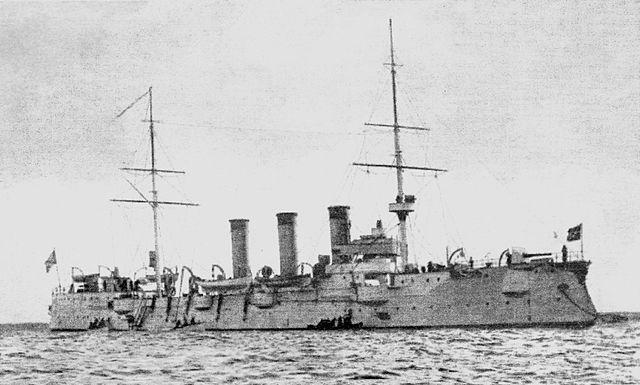
Boyarin received in Copenhagen her final crew before commission on 1st September 1902, and departed for the Baltic Fleet, arriving in Kronstadt on 6 October under command of Captain Sarychev, now formally. On 8 October, she as assigned to the Russian Pacific Fleet reinforcement squadron under Admiral Baron Stackelberg. However as she departed for her long trip, she broke down en route and had to be repaired in Denmark at Burmeister Yard. She at last joined the waiting squadron on 19 November, off the Isle of Portland UK, when Commander Sarychev reported to local authorities his chief engineer “died of gunshot wounds”. Boyarin managed to reach the Mediterranean, passed the Suez Canal, and detached to make a show of force in the Persian Gulf to bolster Russian political interests.
On 4 to 8 March 1903, she visited Kuwait and exchanged salutes witrh the French colonial cruiser Infernet. She carried the Russian Consul at Bushire, modern Iran to meet Ibn Saud, ruler of Najd in Kuwait at the time, for financial assistance and rifles. On 15 March Boyarin and Infernet sailed to Muscat. This was not seen well by Buckingham, as a very grave menace to British interests in the oilèrich Persian gulf. Coaling rights were refused at any British port so the Russian government officially requested help from a French collier in Djibouti to stay with her for coaling until reaching the Indian Ocean. To put things into context, there were two competing alliances at the time: The Franco-Russian alliance turned against Germany, and the British-Japanese alliance to counter the growing influence of the Russian Empire in the far east.
Boyarin eventually reached Port Arthur on 13 May 1903.
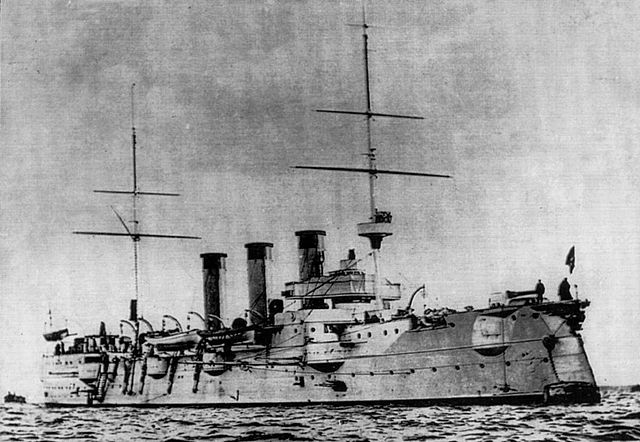
Boyarin was assigned to First Pacific Squadron fleet manoeuvers in Yellow Sea, and in June, the same took place in the Pacific Ocean. In August she took part in even more advanced training exercises, complete with gunnery drills and torpedo launched. This revealed her shortcomings were less severe as anticipated and she was even praised by Viceroy Yevgeni Ivanovich Alekseyev for her utility and low consumption of coal.
Increasing diplomatic tension between Japan and Russia however saw Boyarin reassigned to the port of Chemulpo (Incheon), Korea by December 1903 in order to protect Russian interests in the country. She stayed on station, showing the flag until relieved by Varyag on 30 December 1903 and headed back to Port Arthur.
Battle of Port Arthur
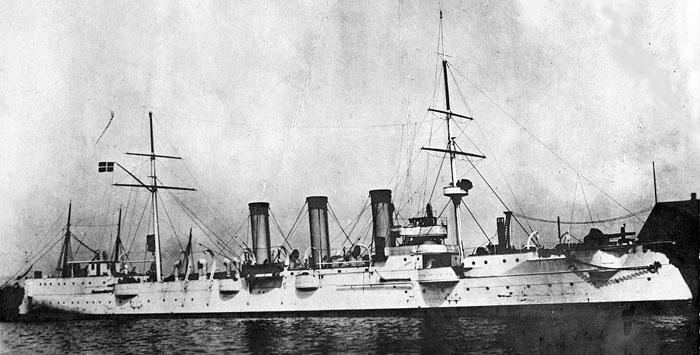
On the night of 8 February 1904, she was at the heart if the opening battle of the Russo-Japanese War: After the IJN destroyers pre-emptive night torpedo attack on the roadstead outside Port Arthur, Admiral Oskar Stark scrambled a squadron in pursuit, inclkuding Boyarin. In the confusion they fired at a Russian destroyer heading into port and folded down.
As a new Japanese squadron was approaching, Boyarin was deployed at the outer roadstead to block their arrival. This was Admiral Togo’s main battle fleet, upon which Boyarin fired three warning shots before folding back in Port Arthur, under the big guns protection, raising the alarm. In the evening, she was tasked to escort the minelayer Yenisei to Talienwan (west Port Arthur to lay the last defensive minefields) but while underway, on 11 February 1904, the minelayer struck one of the older mines.
The blast on Yenisei, built on civilian specs, was devastating. Having no compartimentation or double hull, the explosion tore down her plating, communicated to her mine storage as she exploded and sank rapidly. The blast was impressive, seen from a distance and shore-based observers reported another seemingly Japanese destroyers attack by Japanese destroyers. Thus, Boyarin was dispatched with four Russian destroyers to investigate and struck in turn one of the mines just laid by Yenisei,. It happened at 08:16 on12 February 1904. The blast killed ten crew members immediately, and she sank up to her portholes. Using Makaroff plating, the crew attempted to patch her down when she listed, Commander Sarychev eventually sw the futility of it all and ordered abandon ship. Later, an inspection team from Port Arthur looked after her. She was located further to the shoreline, grounded and with still repairable damage. But a storm hit the next night and she drifted helplessely onto two more mines or more and and sank. She was located several dys later 40 meters (130 ft) away from the shoreline, attempts of salvaging her stopped. Sarychev was court-martialled for prematurely abandoning a still repairable, only damaged ship. He was demoted and placed on shore duty (but saved his crew).

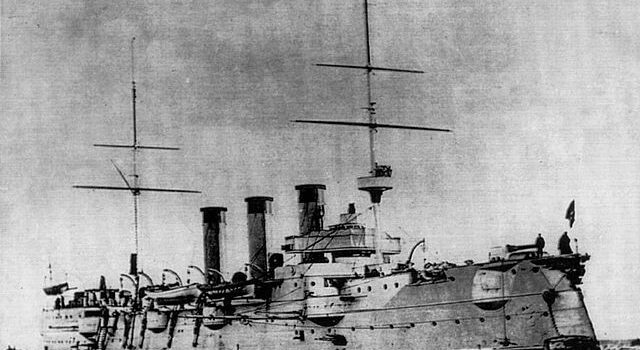
 Latest Facebook Entry -
Latest Facebook Entry -  X(Tweeter) Naval Encyclopedia's deck archive
X(Tweeter) Naval Encyclopedia's deck archive Instagram (@navalencyc)
Instagram (@navalencyc)





 French Navy
French Navy Royal Navy
Royal Navy Russian Navy
Russian Navy Armada Espanola
Armada Espanola Austrian Navy
Austrian Navy K.u.K. Kriegsmarine
K.u.K. Kriegsmarine Dansk Marine
Dansk Marine Nautiko Hellenon
Nautiko Hellenon Koninklije Marine 1870
Koninklije Marine 1870 Marinha do Brasil
Marinha do Brasil Osmanlı Donanması
Osmanlı Donanması Marina Do Peru
Marina Do Peru Marinha do Portugal
Marinha do Portugal Regia Marina 1870
Regia Marina 1870 Nihhon Kaigun 1870
Nihhon Kaigun 1870 Preußische Marine 1870
Preußische Marine 1870 Russkiy Flot 1870
Russkiy Flot 1870 Svenska marinen
Svenska marinen Søværnet
Søværnet Union Navy
Union Navy Confederate Navy
Confederate Navy Armada de Argentina
Armada de Argentina Imperial Chinese Navy
Imperial Chinese Navy Marinha do Portugal
Marinha do Portugal Mexico
Mexico Kaiserliche Marine
Kaiserliche Marine 1898 US Navy
1898 US Navy Sovietskiy Flot
Sovietskiy Flot Royal Canadian Navy
Royal Canadian Navy Royal Australian Navy
Royal Australian Navy RNZN Fleet
RNZN Fleet Chinese Navy 1937
Chinese Navy 1937 Kriegsmarine
Kriegsmarine Chilean Navy
Chilean Navy Danish Navy
Danish Navy Finnish Navy
Finnish Navy Hellenic Navy
Hellenic Navy Polish Navy
Polish Navy Romanian Navy
Romanian Navy Turkish Navy
Turkish Navy Royal Yugoslav Navy
Royal Yugoslav Navy Royal Thai Navy
Royal Thai Navy Minor Navies
Minor Navies Albania
Albania Austria
Austria Belgium
Belgium Columbia
Columbia Costa Rica
Costa Rica Cuba
Cuba Czechoslovakia
Czechoslovakia Dominican Republic
Dominican Republic Haiti
Haiti Hungary
Hungary Honduras
Honduras Estonia
Estonia Iceland
Iceland Eire
Eire Equador
Equador Iran
Iran Iraq
Iraq Latvia
Latvia Liberia
Liberia Lithuania
Lithuania Mandchukuo
Mandchukuo Morocco
Morocco Nicaragua
Nicaragua Persia
Persia San Salvador
San Salvador Sarawak
Sarawak Uruguay
Uruguay Venezuela
Venezuela Zanzibar
Zanzibar Warsaw Pact Navies
Warsaw Pact Navies Bulgaria
Bulgaria Hungary
Hungary

 Bundesmarine
Bundesmarine Dutch Navy
Dutch Navy Hellenic Navy
Hellenic Navy Marina Militare
Marina Militare Yugoslav Navy
Yugoslav Navy Chinese Navy
Chinese Navy Indian Navy
Indian Navy Indonesian Navy
Indonesian Navy JMSDF
JMSDF North Korean Navy
North Korean Navy Pakistani Navy
Pakistani Navy Philippines Navy
Philippines Navy ROKN
ROKN Rep. of Singapore Navy
Rep. of Singapore Navy Taiwanese Navy
Taiwanese Navy IDF Navy
IDF Navy Saudi Navy
Saudi Navy Royal New Zealand Navy
Royal New Zealand Navy Egyptian Navy
Egyptian Navy South African Navy
South African Navy






























 Ukrainian Navy
Ukrainian Navy dbodesign
dbodesign